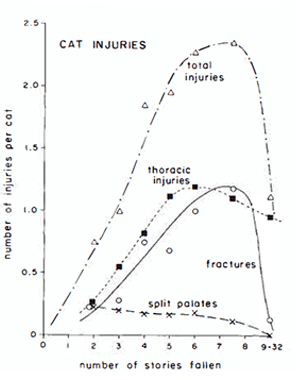
Students practice Claim, Evidence, and Reasoning (CER) while examining the relationship between falling height and cat injuries.
The graphs show that cats who fall 2-7 stories often suffer more injuries than cats who fall from greater distances. Not much information is given about how the data was collected, though the original source is included, I find this a good time to talk to students about ethics in research. Some students will question how the data was gathered, and suspect that scientists wouldn’t throw cats off buildings. The data was actually gathered from veterinary reports of cats who were treated after falls.
Students first analyze data from a table, then read an article from Nature titled “Why Cats Have Nine Lives” which goes into greater detail about why cats can survive falls that would kill humans. Students use the articles and accompanying graphs to identify the CLAIM that is being made by the author and the EVIDENCE given.
Some of the vocabulary in the article may be difficult for some biology students, particularly words related to veterinary and anatomical concepts. For example, the graph shows a line to denote the number of “split palates” recorded for falls. Students may not know that a split palate refers to a mouth/chin injury.
The handout I give students is an abridged version of the original publication. You could also share the original article.
Scientific Reasoning Skills
I spend the first couple of weeks on scientific reasoning. This include an introduction to CER, using statistics. These students will also do an advanced lab on Oreo cookies. In this lab, they determine if double Oreos are really double-stuff.
I also show this video to students after they’ve analyzed the data because it helps them to visualize how cats manage to survive these falls and understand how terminal velocity works.

